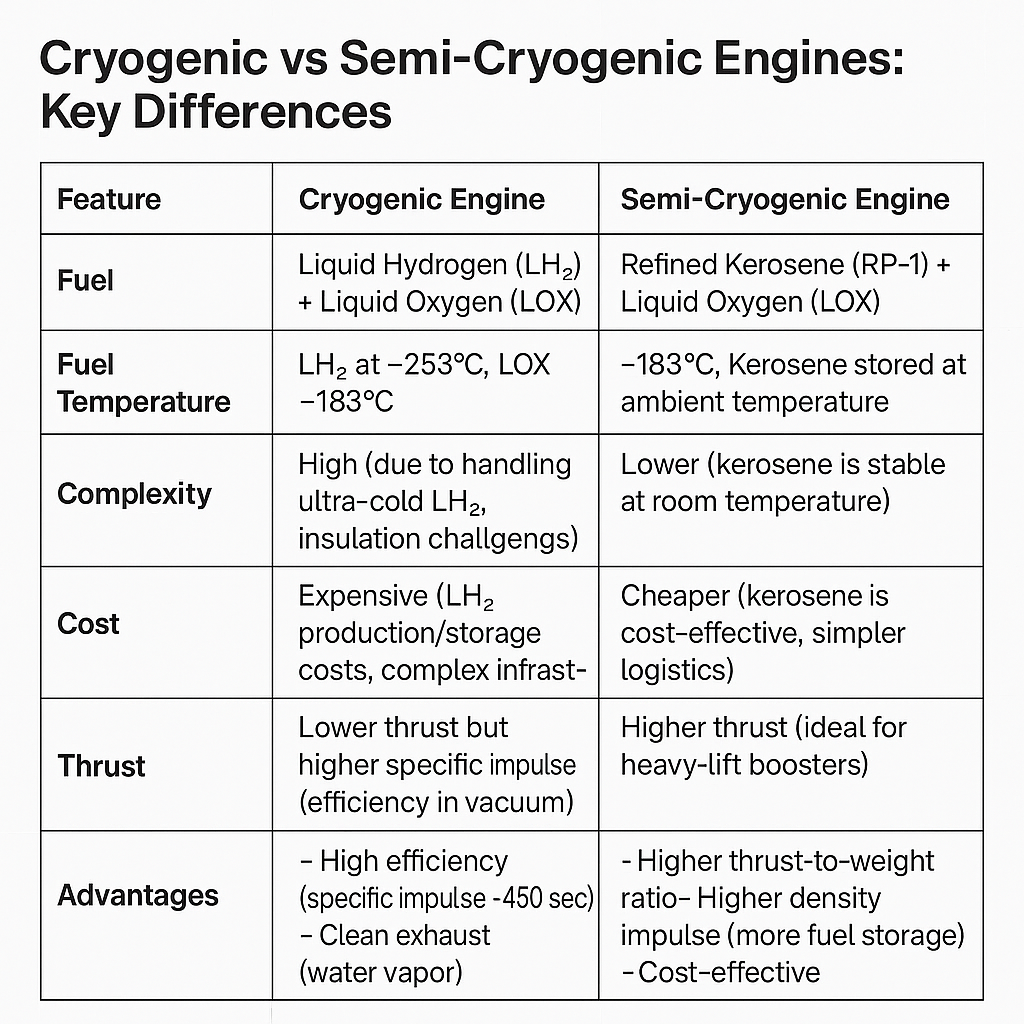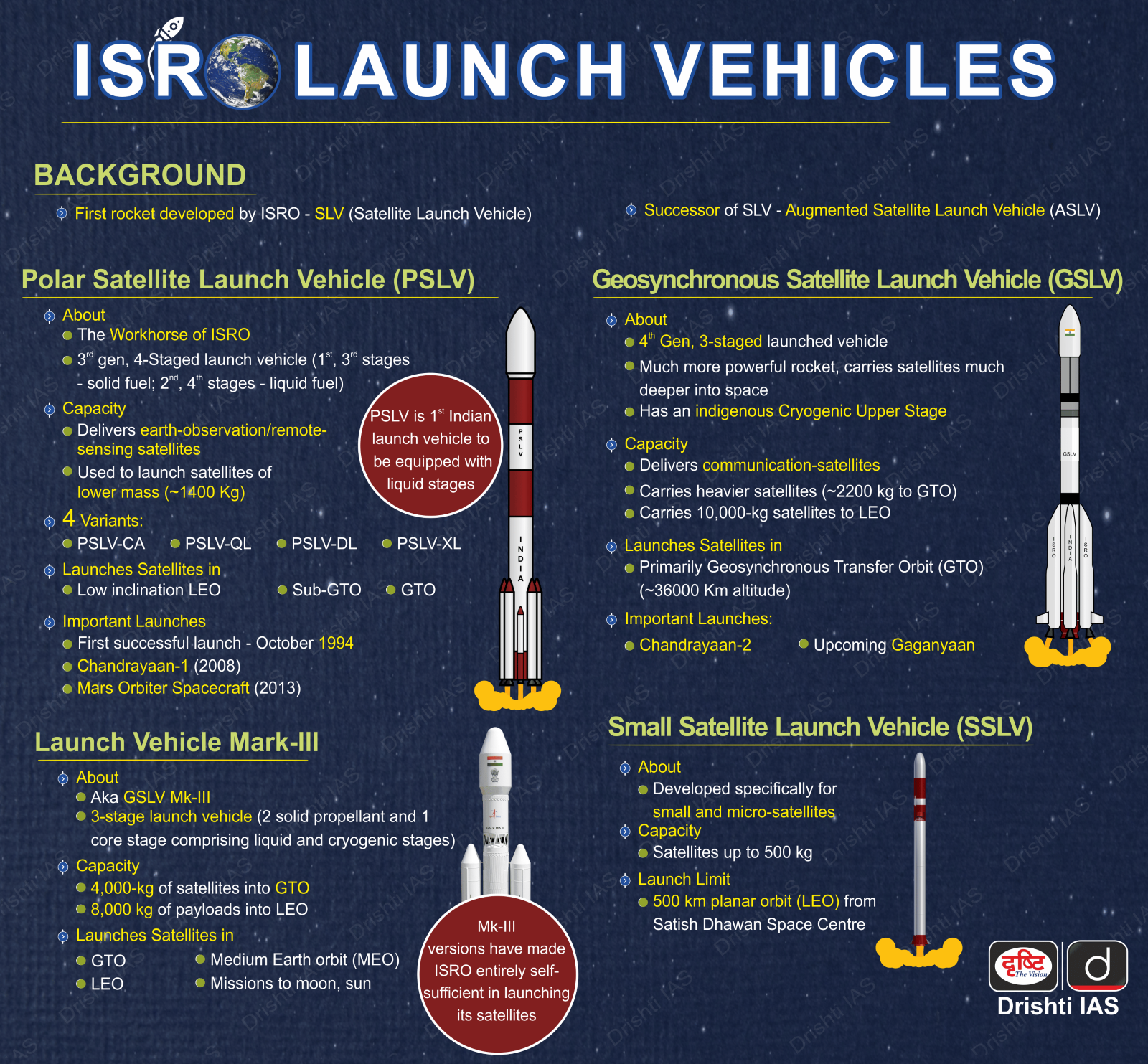ISRO to Launch LVM3 with Semi-Cryogenic Stage | 07 Aug 2025
Why in News?
The Indian Space Research Organisation (ISRO) has set the target for the first quarter of 2027 for the inaugural flight of its LVM3 launch vehicle equipped with a semi-cryogenic propulsion stage.
What are the Cryogenic and Semi-Cryogenic Engines?
- Cryogenic Engine/Cryogenic Stage: A cryogenic stage uses Liquid Oxygen (LOX) and Liquid Hydrogen (LH2) as propellants, liquefied at -183°C and -253°C, respectively.
- It is used in the upper stage of launch vehicles like GSLV, offering high efficiency and thrust.
- Cryogenics is also used in MRI machines (using liquid helium for cooling), food storage and preservation, special effects (artificial fog), recycling (material separation), biomedical preservation (freezing blood and tissue samples), and in cooling superconductors for scientific and industrial use.
- India developed its own cryogenic technology with the first engine test in 2003 and first successful flight in 2014 (GSLV-D5/GSAT-14).
- Semi-Cryogenic Engine: A Semi-Cryogenic Propulsion Engine/Stage uses a combination of liquid oxygen (LOX) and refined hydrocarbon fuel (e.g., kerosene) as propellants.
- It is designed to power the booster stages of future heavy-lift launch vehicles and offers higher density impulse than cryogenic systems, enhancing overall propulsion performance. It will support upcoming platforms like the Next Generation Launch Vehicle (NGLV).

What is the LVM3 Launch Vehicle?
- About: LVM3 is ISRO’s most powerful, heavy-lift, 3-stage launch vehicle, formerly known as the Geosynchronous Satellite Launch Vehicle Mk III (GSLV Mk III).
- It had its first experimental flight in December 2014 and is capable of launching payloads up to 4000 kg to Geosynchronous Transfer Orbit (GTO).
- 3 Stages:
- First Stage: Two S200 solid strap-on boosters attached to the sides of the core, using hydroxyl-terminated polybutadiene (HTPB) as the solid propellant.
- Second Stage (Core Stage): The L110 liquid stage powered by twin Vikas engines, which burn a combination of unsymmetrical dimethylhydrazine (UDMH) and nitrogen tetroxide (N₂O₄).
- Third Stage (Upper Stage): The C25 cryogenic stage powered by the CE20 engine, using liquid hydrogen (LH₂) and liquid oxygen (LOX) as propellants.
- Key Upgrades in LVM3 Launch Vehicle:
- The LVM3 upgrade replaces the L110 liquid stage with the SC120 semi-cryogenic stage powered by the SE2000 engine (200-tonne thrust), using refined kerosene (RP-1) and LOX.
- It also increased the C25 cryogenic stage capacity to 32 tonnes. This enhances GTO payload capacity to around 5,200 kg, reduces launch costs by around 25%, and improves environmental safety.
- The upgrade boosts India’s heavy-lift capability for future satellite missions and aligns with ISRO’s next-gen launch plans.
What are the Key Missions Launched by ISRO’s LVM3 Rocket?
|
Mission Name |
Launched In |
Payload / Objective |
Remarks |
|
LVM-3/CARE Mission |
2014 |
Experimental suborbital flight, tested re-entry |
|
|
LVM3-D1 / GSAT-19 Mission |
2017 |
GSAT-19 communication satellite |
First orbital test launch |
|
LVM3-D2 / GSAT-29 Mission |
2018 |
GSAT-29 Mission communication satellite |
Demonstrated heavy communication satellite launch |
|
LVM3-M1 / Chandrayaan-2 |
2019 |
Chandrayaan-2 lunar orbiter, lander, and rover |
|
|
LVM3-M2 / OneWeb India-1 |
2022 |
36 OneWeb Gen-1 satellites (Low Earth Orbit, LEO) |
OneWeb India-1 Mission |
|
LVM3-M3 / OneWeb India-2 |
2023 |
36 OneWeb Gen-1 satellites (LEO) |
|
|
LVM3-M4 / Chandrayaan-3 |
2023 |
Chandrayaan-3 lunar lander and rover |
India’s 3rd lunar mission |
UPSC Civil Services Examination, Previous Year Question (PYQ)
Prelims
Q. With reference to India’s satellite launch vehicles, consider the following statements: (2018)
- PSLVs launch satellites useful for Earth resources monitoring whereas GSLVs are designed mainly to launch communication satellites.
- Satellites launched by PSLV appear to remain permanently fixed in the same position in the sky, as viewed from a particular location on Earth.
- GSLV Mk III is a four-stage launch vehicle with the first and third stages using solid rocket motors, and the second and fourth stages using liquid rocket engines.
Which of the statements given above is/are correct?
(a) 1 only
(b) 2 and 3
(c) 1 and 2
(d) 3 only
Ans: (a)


